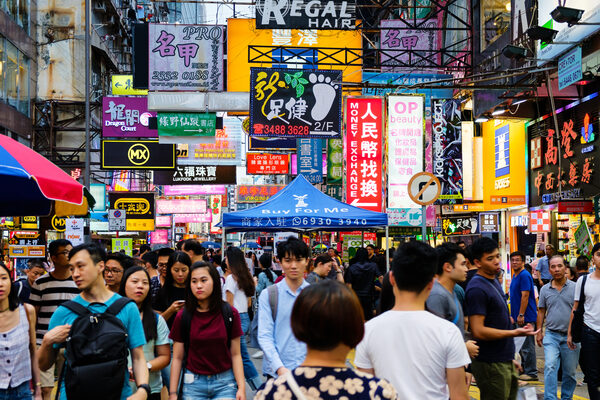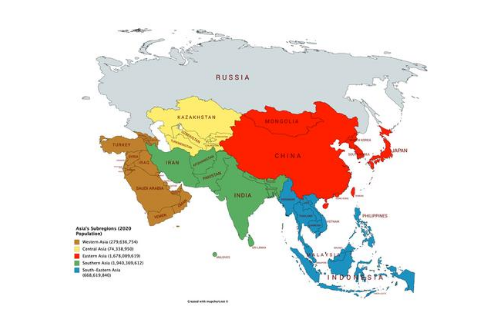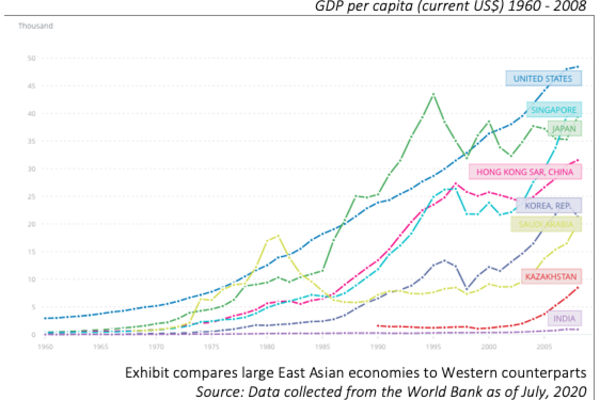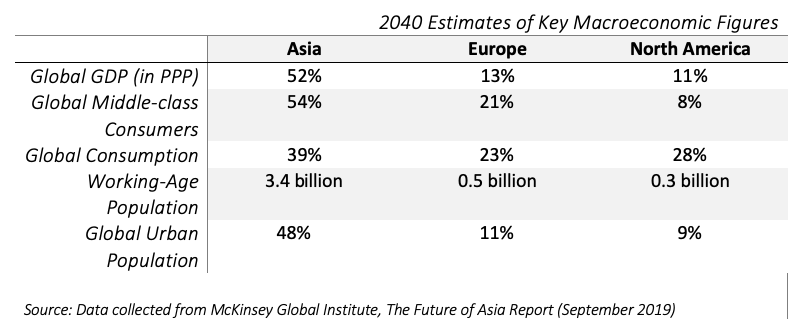The Asian Century just arrived. Now get ready.

Opinions in this article are the author’s and do not necessarily reflect those of Cornell, Johnson, or the Emerging Markets Institute.
Covering about 30 percent of Earth’s total land area with 4.6 billion people (60 percent of the world’s population), Asia is the largest and most populated continent. Home to 48 countries, the continent can be divided into five main subregions which include Western Asia, Central Asia, Eastern Asia, Southern Asia, and South-Eastern Asia. These regions are highly diverse with different economies, governmental systems, demographics, and geographical landscapes. There are about 2,300 languages spoken across Asia with GDP per capita (current US$) ranging from $1,071 in Nepal to $65,233 in Singapore. Considering the size and diversity of the Asian continent, it is not always appropriate to view it as a whole but rather a collection of spheres.

Asia’s past and history
The Asian continent has a very rich history. From the second century BCE to the 15th century, Asia’s East and West were connected through a series of trade networks known as the Silk Road. This permitted the exchange of goods and ideas. Silks, teas, porcelain, and spices went to the West, while wools, gold, and sliver went to East. The Silk Road, with its roots tied to China’s Han Dynasty, can be a main reason why the narrative of the continent has been traditionally told by East Asia.
Likewise, in Asia’s most recent past, mainly after the Second World War, East Asia has been the catalyst for most of the continent’s economic growth. During this time, it underwent three main economic developmental waves that stemmed growth: (1) Japan, lasting from the 1950s to 1970s; (2) the four Asian Tigers—Taiwan, Hong Kong, South Korea, and Singapore—lasting from the 1960s to early 1990s; and (3) China, lasting from the 1980s to the global financial crisis of 2007–2008. During these developmental waves, each country started to rapidly industrialize and then transition from labor-intensive production to more capital-intensive activities. Growth was driven by factors like higher savings and educational attainment levels coupled with governmental policies that favored foreign direct investment and export-oriented economies. This led to a rise in the GDP per capita (current US$) in East Asia and the Pacific by more than 4,300 percent from 1960 to 2008 and has brought over one billion Asians out of poverty.

Asia’s economic transformation—stimulated by many Eastern countries on the continent—over the past 60 years is unprecedented. This has caught the attention of academics, politicians, and economists alike and thus the term The Asian Century has emerged. This is often used to describe the projected 21st century dominance of Asia and the Pacific in business, government, and culture, assuming current economic, political, and demographic trends persist. Such trends can include Asia’s rising consumption levels, growing middle class, higher levels of intra-regional trade and supply chain networks, increasing investments in technology and urban infrastructure, China’s expanding geopolitical influence, and more. In The Asian Century the center of the world will shift Eastward as Asia defines the next phase of globalization.
Asia’s present
Though this theory started to gain ground in the early 1980s, when exactly did The Asian Century start? Was it when China—the largest economy on the continent—began to industrialize in the 1980s? At the turn of the millennium? Or perhaps it did not even start yet and the movement will take hold in 2040 when Asia is expected to top 50 percent of global GDP.
While these are all fair guesses, there is no one specific event that marks this transition. In actuality, The Asian Century has just arrived and we are living in it now. There are four main events that have acted as accelerants for this transition. When analyzing these events, it is important to note how China is indeed a driving force due to its economic and political clout.
The global financial crisis (2007–2008). The global financial crisis was a period of extreme pressure on global financial markets and banking systems between mid-2007 and late-2008. This crisis originated in the United States and is attributable to lax-lending standards, poor financial regulation, and an asset bubble in the domestic real estate sector. In the aftermath of the crisis during 2009, advanced Western economies experienced a decline in GDP: U.S. (-2.5 percent), U.K. (-4.2 percent), France (-2.9 percent), and Germany (-5.6 percent). Many Asian economies, in fact, thrived: China (+9.4 percent), India (+8.5 percent) Vietnam (+5.4 percent), and Indonesia (+4.7 percent).
China’s Belt and Road Initiative (2013). Officially launched in 2013, China’s Belt and Road Initiative (BRI) is a $1 trillion USD global infrastructure developmental program that aims to connect China with the rest of Asia, Africa, the Middle East, Europe, and the Americas. Over the past decade, China has provided loans to other governments—most in Asia—to help finance their infrastructure projects in sectors like transportation and logistics, public housing and urban development, renewable energy, technology, and more. When countries have been unable to make repayments, China has historically seized their state-controlled assets—similar to what was done with Hambantota Port in Sri Lanka. The BRI is one way that the Asian continent is becoming more interconnected both economically and politically.
U.S. presidential election (2016). When Donald Trump was elected president, his administration adopted a tougher approach on trade relations with Asia—China in particular. Pointing to the rising U.S. trade deficit with China, his administration felt emboldened to launch a trade war demanding more favorable terms. During the past four years, a number of tariffs and restrictions were placed on Chinese businesses which financially hurt multinationals like Huawei and ZTE. Trump’s aggressive policies toward China were really a wake-up call for the country, and most of the region, to start distancing itself from the United States and the West in order to become more economically independent. The Trump administration has also adopted more isolationist policies by withdrawing from the World Health Organization, the Paris Agreement, and the Trans-Pacific Partnership. Thus, America’s decline as a leader on the world stage has provided a strategic opportunity for other countries, like China, to take its place.
COVID-19 (2019). This worldwide public health crisis that originated in Asia has upended almost every part of society—school, the office, field work, dining, sports, shopping, etc. In many respects, Asia has been ahead of many advanced Western nations in terms of the progression and response to the pandemic. Many Asian countries, most notably China, Vietnam, and South Korea, have been very quick to handle the virus and have flattened the curve much sooner by implementing statewide lockdowns, speeding up COVID testing, and promptly implementing travel restrictions. This has led to a more rapid economic recovery and less fatalities compared to the West. To date, COVID is the strongest signal of Asia’s debut onto the world stage as Asia showed the world its efficiency in government, business, and healthcare.
Asia’s future
When analyzing how Asia may transform over the coming decades, it is important to keep in mind the following points. First, China is the largest economy on the continent by far. From 1978 to 2018, the country’s annualized GDP growth rate was 9.5 percent. It also generated the majority of worldwide growth during the 2010s decade. Such high growth for such a sustained amount of time is unprecedented. Because of China’s economic weight on the continent, it is important to analyze Asia both within and without the context of China. Second, though technically still part of Asia, Western Asia and the Anatolia are very different economically, politically, and culturally from the rest of the continent. Many Western Asian economies are centered around oil production and their governments tend to be less democratic in nature. While Western Asia will certainly play a role in the narrative of The Asian Century, its impact will be less pronounced than the continent’s East.

Focusing first on China, the country will be the driving force that propels the Asian continent for most of the century. Chinese multinationals like Tencent, Alibaba, Huawei, and Baidu and state-owned enterprises like ICBC and China National Petroleum Corporation will continue to dominate the East and South-Eastern Asia Pacific. These entities will emerge as formidable competitors to their Western counterparts. China will also start to gradually move away from labor-intensive manufacturing and become more of a hub for finance, entrepreneurship, and technological innovation for the region as a whole. To an extent, this is already shown by initiatives like Made in China 2025 and rising labor costs in the country. As of January 2020, the world’s four largest banks by AUM were Chinese and the country accounted for one third of global unicorns.
Focusing on the rest of Asia, a few key themes may persist. Economically, Asia will be more intra-regionally connected on several dimensions such as trade, supply chains, manufacturing, travel, and foreign direct investment—in this sense, Asia will become more Asian. The continent’s share of global consumption and the world’s middle class is expected to rise to 39 percent and 54 percent by 2040 compared to 2017 levels of 28 percent and 40 percent, respectively, according to the McKinsey Global Institute. Politically and socially, however, Asia may become more fragmented into its subregions (e.g. Western Asia, Southern Asia, Central Asia, etc.). Each subregion may develop a distinct identify that is separate from the rest of the continent—a trend accelerated by COVID.
Lastly, Asia will likely undergo another developmental wave. This time it will be through the Tiger Cub economies—Indonesia, Malaysia, the Philippines, Thailand, and Vietnam—of South-Eastern Asia. Just like the Four Asian Tigers were the center of Asia’s growth from 1960s to 1990s, these new Tiger Cub Economies will be where most of the continent’s growth will stem from in the coming decades—supported by their relatively high GDP growth rates and improved education and health services over the past 20 years. The South and South-Eastern Asia Pacific region will see more growth as countries like India and Bangladesh continue to digitalize via polices like Digital India and Bangladesh Vision 2021, which promote advancements in technology, media, and telecommunications, while countries like Vietnam and the Philippines may likely continue to produce more consumer durables as China moves away from being “the world’s factory.”


Comments